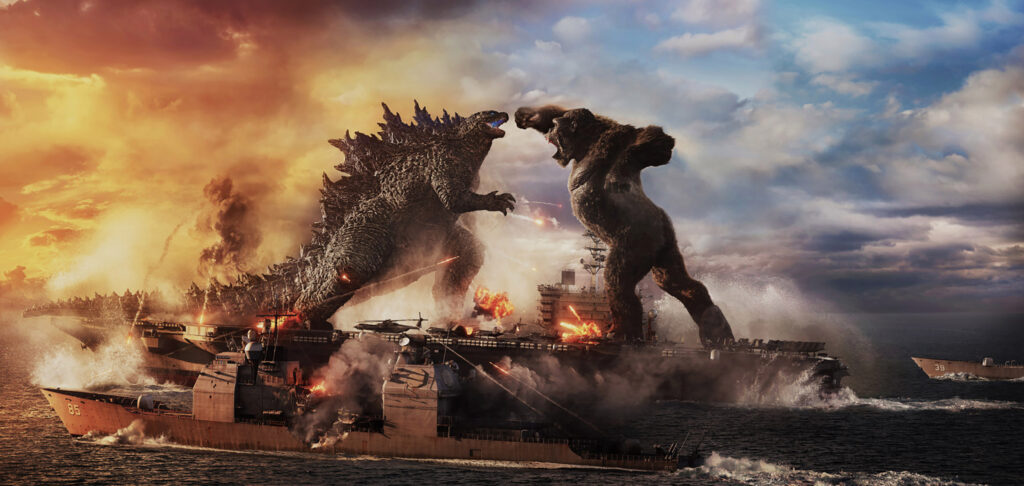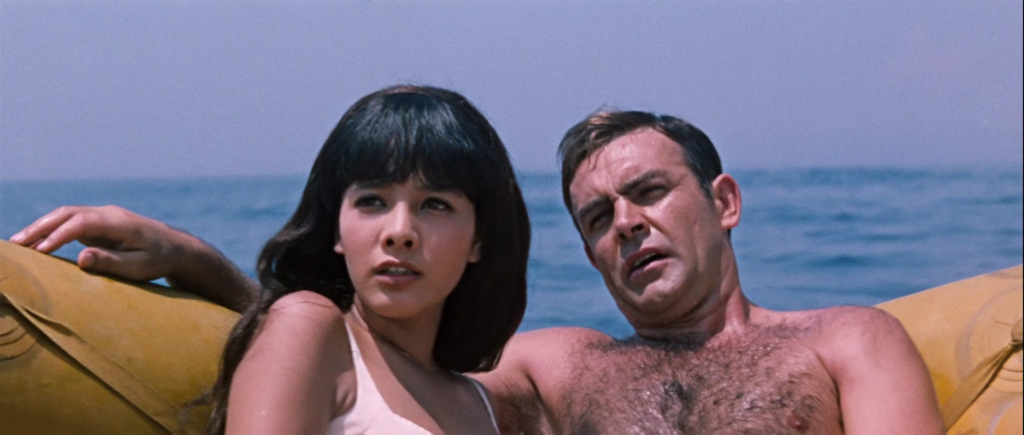Kong Vs. Godzilla (Part One)

BUMPED 3/31/2024
In a pre-Star Wars universe, guys in silly rubber costumes tramping around flimsy sets were awesome.
Give a kid a bunch of cardboard boxes and a crayon and within minutes there were would be a Tokyo skyline. All ready to be stomped flat by a hunched over boy, who occasionally interruppted the carnage to give his mighty Godzilla roar.
When I was nine, my only sources of income were scouring parking lots for dropped change, returning pop bottles, and (for one summer) cutting the teeth out of sharks that had drowned in the nets for the creepy guy who made necklaces out of them.
That was more than enough for an eight pack of Coke and a big bag of Fritos. Come three o’clock on Saturday afternoon, the Godzilla movie would start on UHF. And let me tell you, boy, I was set!
But after Luke, Han and the gang showed up, the wind kind of went out those sails. We didn’t abandon Godzilla completely, not overnight. But the bar had been set a bit higher and the Kaiju movies of the Seventies couldn’t clear them.
Godzilla movies eventually became a source of drunken entertainment with your college friends. The memories were warm, but the magic was gone.
One of the silliest of the Godzilla movies was King Kong Vs Godzilla. And I remember thinking when I was a little kid that it was total bullshit that Godzilla lost. I mean come on, Kong was just a big monkey, he didn’t have atomic breath or a cool roar.
But now after sixty years there is going to finally be a rematch.
The hype has gone to eleven for this one. And the people hyping it ordinarily would know better. Legendary Films have given us two Godzilla movies and one King Kong and all three have sucked.
The box office take on all three films has been borderline but never disastrous. Godzilla (2014) made $524 million against a budget of $160 million. Kong Skull Island made similar bank. Godzilla King of the Monsters was an almost loser that didn’t quite cross the border at $386 million against a budget of $170 million. The very, very rough rule of thumb is that a film has to make double it’s budget in order to turn a profit. Legendary had to have been strongly considering pulling the plug and calling it good after the last one. As I said, profitable but only barely and Legendary Films had gone into these projects hoping to break a billion dollars, which they never got near.
But they did have a franchise and someone willing to foot the bill which meant they were honor bound to find out if there is any more blood in that stone.
Have a trailer, it actually is pretty good:
Of course, so were the other trailers for the Legendary Kaiju films.
Let’s take a look at where these two contenders for the crown of Greatest of All Time came from.
King Kong 1933 was so original and so groundbreaking, that you know in your heart that it couldn’t be either of those things. Hollywood has never gone in for anything like that.
Kong’s fathers were Arthur Conan Doyle and H.G. Wells. Doyle’s The Lost World gave us a setting that featured dinosaurs chasing humans. Wells’s contribution was the Island of Doctor Moreau, which gave rise to the “jungle movies” of the silent era.
The jungle movies were a genre of pre-Hayes Office films that followed a general plot of explorers go into the bush and discover some weird, freakish abomination in the eyes of god. In 1930 this tradition reached its apex with Ingagi.
Ingagi was a “documentary” about a tribe of African women who worshipped gorillas. As this was pre-code there was quite a bit of “cultural nudity.” As for the plot: Do you remember how whenever King Kong is about to get overly friendly with Fay Wray or Jessica Lange, he’d get cock-blocked by a giant snake monster? No such luck for the women in Ingagi, the gorilla gets to finish what it starts, and this results in a deformed hybrid baby.
Ingagi is a lost movie with only a few stills remaining and thank god for it.
King Kong was the final inheritor of a tontine of exploitation films. Various elements got smashed together to create a monster (sorry) hit. 1930s audiences were quite familiar with these elements and it had an intrinsic air of mystery that resounded with them. Remember in 1933 some pretty big chunks of the planet could still be said to be unexplored. An island with giant gorillas and dinosaurs was pretty unlikely but the Coelacanth had been presumed extinct and live specimens were found off the coast of South Africa so who knew for certain?
The stop motion effects were best in their day. Fights between giant creatures have always been cool. And the sexploitation was kept within the bounds of taste if not logic or believability. King Kong was a worldwide hit. And the Japanese in particular appear to have been entranced by him.
There were two Japanese King Kong ripoffs known to have existed in pre-war Nippon. Wasei Kingu Kongu and King Kong Appears in Edo. One was a three-reel comedy, the other was probably the first Kaiju movie (technically). The latter is very much a lost movie, which is hardly a surprise since less than 1% of Japan’s pre-war films are known to have survived the war.
Gojira (1954) was a film with balls of titanium. Think about it, this was a film that prominently featured a Tokyo that was in flames just nine years after Tokyo had literally been flames. There were very few people in the audience that didn’t know someone who had died in the war. In its day Gojira was edgy enough to cut atoms.
It was quite a bit more serious than King Kong ever was or ever could be. Gojira was an expression of Japan’s coming to grips with the Atomic Age and that hadn’t really worked out so well for Japan. The inspiration for the film was an incident where a Japanese fishing boat got caught in the fallout of a US nuclear test and the crew died of radiation poisoning. It brought back a lot of memories of Hiroshima and Nagasaki.
Doctor Serizawa’s use of the Oxygen Destroyer had a deep resonance with the Japanese of the 1950s. His profound reluctance to use it, even in the face of the unimaginable destruction the monster was inflicting on Japan struck a deep and resounding chord with its audience.
The American version, Godzilla, was badly edited and badly dubbed. Minimal credit where it’s due, the dubbing wasn’t entirely their fault. Japanese and English are simply too different for a smooth translation. That said it didn’t need to be so bad that you would still be hearing English dialog even after the Japanese actor had hung up the phone and walked off-screen. The editing stripped out a lot of the things that took Gojira to the next level as a film. It was made worse by inserting Raymond Burr as American Scientist-Man. One thing that did stay was Godzilla’s very distinct and completely copyright protected roar.*
I think the one thing that wasn’t the fault of the American version was coming up with the name, “Godzilla.” If you watch the original version. The Toothless Fisherman is the first one to call the creature, ‘Gojira,” but because of his complete lack of teeth his pronunciation of the word sounds distinctly like, “Godzilla.” To American English speakers the word felt like a compound evocation of “god-lizard,” which was pretty close to a perfect name for the monster.
While the version we got was silly, it was still pretty watchable.
Nonetheless, as good as Godzilla started out, it went downhill fast. After Gojira, came Godzilla Raids Again (1955) where he takes on the first of his many Kaiju opponents, an oversized Ankylosaur. He went on a seven-year hiatus until Toho secured the rights to King Kong for a single, one-time licensed appearance.
The King Kong portion of this story isn’t too different from the 1933 version. A pharmaceutical company wants a sensation and sends a couple of men and NO woman to Ape Island. There they find Kong who after beating up a squid monster gets stoned on some red berry juice and passes out. The Japanese tie him to a raft and set out for the Land of the Rising Sun.
In the meantime, an American nuclear sub crashes into an iceberg. Which as bad luck would have is exactly the one where Godzilla has been imprisoned since 1955. Gratitude is rare in princes and is unknown to Godzilla. He immediately destroys the sub and then a nearby US base. That was just a warmup. Just something to get the kinks out. He hotfoots it back to Tokyo like a homing pigeon.
Kong gets loose and is FINALLY able to get a hold of a woman. But before he can go full Ingagi on Fumiko, he gets cockblocked again.** This time by the JSDF hitting him with more red berry juice. Kong is too stoned to perform after that, so, he puts her down promising to phone her in the morning, then he lays down to sleep it off. Fumiko calls him a jerk and storms off to her apartment.

The JSDF has the strange idea of airlifting Kong to Godzilla’s location in the hopes they will kill each other. Godzilla initially kicks his hairy ass but then Kong gets hit with a lightning bolt which revives him for reasons which are never explained. The two monsters fall into the sea in a clinch. Kong emerges from the water; remembers he didn’t get Fumiko anything for White Day and decides he’d rather go back to Ape Island than deal with a pissed-off Japanese girlfriend. He promptly swims away. Godzilla does not emerge, but it is speculated that he might still be alive. The End.
This flick made enough money both in Japan and in the international market that Toho started grinding Godzilla movies like sausages at a rate of one a year until 1975.
I’ll say this for them, the quality remained pretty consistent throughout. Pretty much all of them are slightly better than average. The only exception being, All Monsters Attack, which was basically a clip show. It’s the one where a bullied kid dreams of going to Monster Island where he makes friends with Godzilla Junior who also gets bullied a lot.
The interesting thing was watching the Japanese attitude towards Godzilla change with time. He went from the unstoppable terror of Nippon to its unstoppable champion. Sure, the cities always got thrashed while Godzilla was saving the day but omelets and eggs you know? Besides if you are living in a major metropolitan area and Kaijus are a known and annual problem in your world, then the drawbacks of living there are on you. You knew what you were getting into. You were the one that couldn’t stand living on the farm. I hope you’re happy Fumiko!
Part Two, The Bad, B-a-d American Godzilla Movies.
*Pixar found out about that the hard way. They tried to use his roar in Monster Inc. Assuming that a Foley sound effect enjoyed no legal protection. And indeed, Foley sound effects don’t. But Godzilla’s roar was made with a cello, thus meeting the legal definition of music. Toho must have been feeling grumpy because they wouldn’t let Pixar license it.
**An adult male gorilla has an erection length of two inches. If Kong is “seven times big as a man” than by extrapolation he’s probably about fourteen inches long. There is the crucial question of width but Kong probably figured he had nothing to lose by trying.

